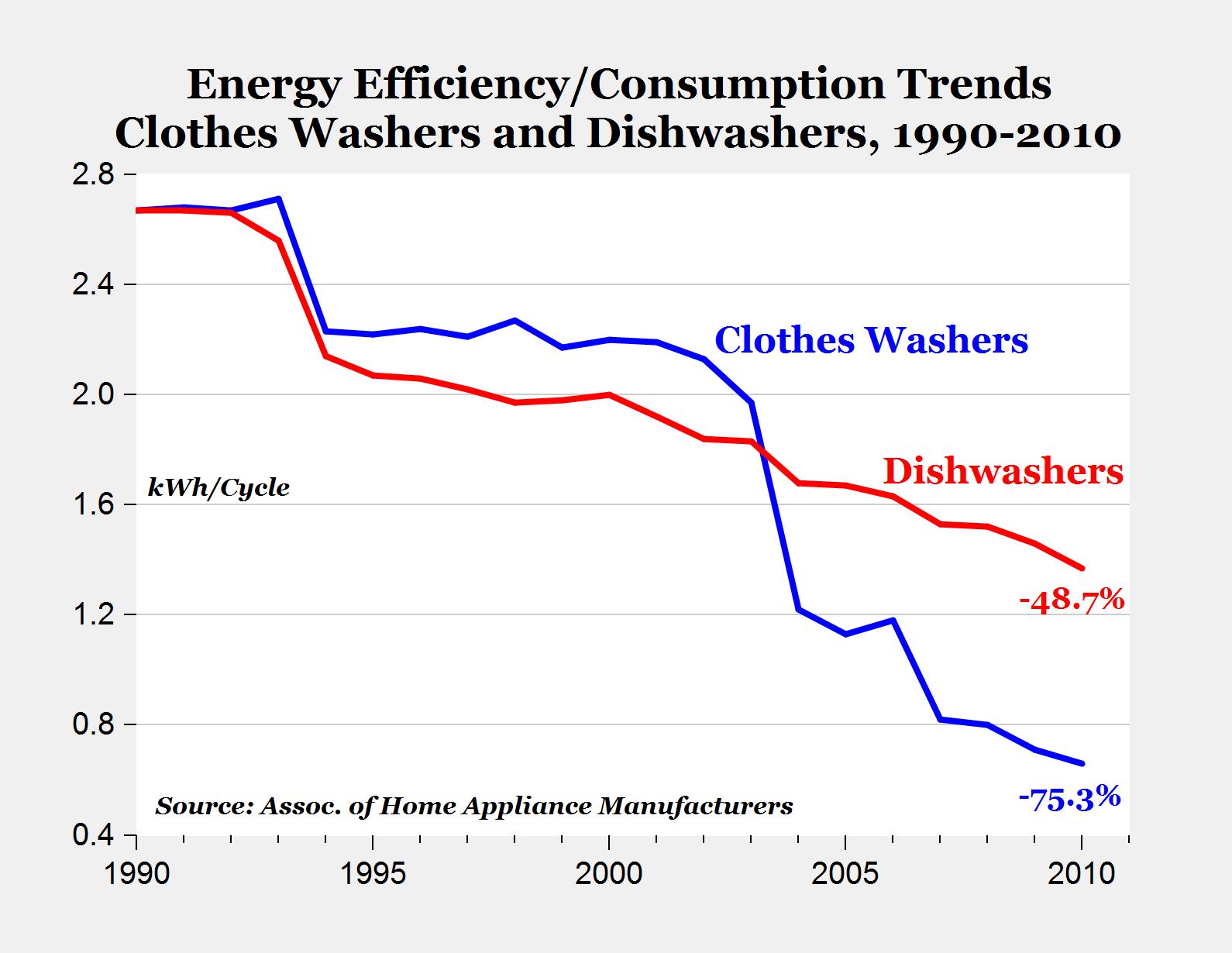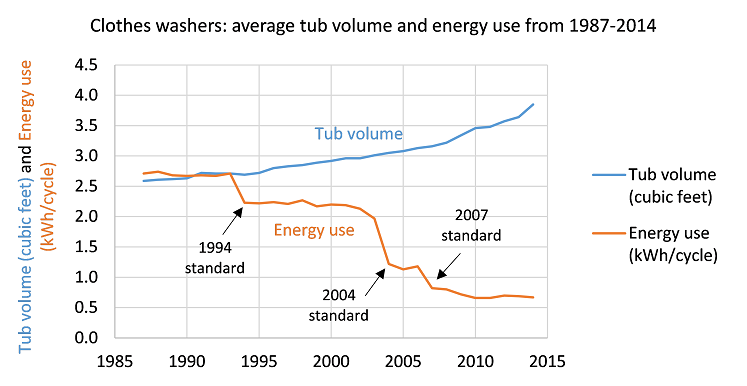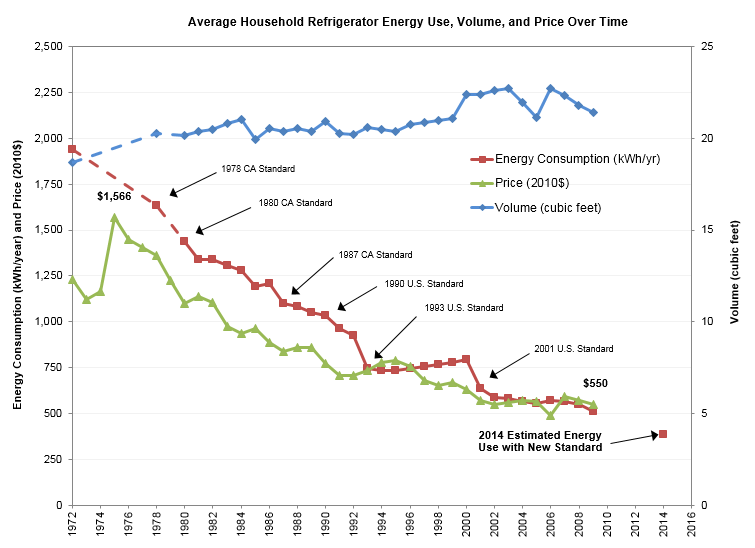

Always have, always will.


Always have, always will.


Got it, so just vibes… Well, since you caught me on a Friday with a light schedule…
Amperage rating is maximum load, not how much it uses the entire cycle. I just so happen to have my washer hooked up to a power meter, and look at that! It doesn’t draw the entire load during the entire cycle (which would look like a flat line)!

Runtime is not correlated with energy use. Energy is actually much more closely linked to water usage, since it takes a lot of energy to heat up all that water for a cycle, and all that water weight causes extra load on the internal motors. The additional runtime of modern washing equipment is mostly idle time to allow for additional soaking, etc. and not contributing much energy use. Historical trends show a pretty steady decline in energy use. Here’s one study that found a 75+% decrease in energy use per load from the 90’s to the early 2010’s:

This is interesting, because when partnered with data on tub size, it actually shows that even as loads get larger, energy use has been decreasing over time:

(source is Association of Home Appliance Manufacturers again).
Back to your original comments about refrigerators, I’ll just add, going from ~1400 kWh/yr in 1980 to ~400 kWh/yr in 2014 is a 72% decrease in energy use (which is amazing), even while real appliance costs have come down AND volume has gone up.

IDK where you live, but 1000 kWh/yr for me would cost ~$250 ($0.25/kWh). Swapping a 1980s fridge with a modern one would pay for itself in just 2-3 years. Hell, I could even splurge for a fancy fridge and still have a payback faster than investing in the stock market.
These gains, largely driven by regulatory efficiency targets, all benefit the consumer and the electricity grid at large. Being cranky about the fact that “they don’t make them like they used to” doesn’t change the fact that meaningful improvements have been made over time.


Got a source to back those claims up?
Are those dollar values normalized to the same year?
You going off data or just vibes, because the only thing here that feels questionable at best is your post.


Sounds like the app worked as intended and she found the mushrooms she was after.
You lost me at “run”. Can I bring my inhaler or does that count as a tool?
Lots of creatures within the realm of benchable weight often have specialized defenses that could constitute a 1-hit KO if you fuck up in the slightest.
A chimp could rip your arms off. A kangaroo could crack all your ribs with a kick.
If you consider these “natural weapons” then sure, I guess that just limits you to fighting juvenile cows or something, at which point I’ll give it to you, I could probably take a newborn calf in a fight.
One punch from my scrawny nerd warrior arms and that fucker would shrug then donkey kick me half way across the fucking Serengeti.
A gorilla at rest stays at rest, just wait for him to go to sleep then you literally can’t lose.
I think… I sucked at gorilla physics class.
The advantage of Tile and AirTags is that they’re relatively dumb devices that leverage passing cell phones to snitch on their location. This means they can last months on a single charge while the phones do the heavy lifting.
There may be more and less private ways to do what they do, but they’ll all have similar tradeoffs.
A device that tracks its own location and reports it out over a cell network would basically require all the complexity and size of a smart phone minus the screen and cost similarly
There are Bluetooth trackers that can be run privately and with enough creativity can be used to identify the location of something within the confines of your home (or know if something is not home), but won’t be much help if you’re trying to track down lost luggage or want to know if you left your wallet at work or the coffee shop. (e.g. https://www.youtube.com/watch?v=-fmBwINdsxQ)
Mindustry.


Clearly you don’t understand, both sides did something I don’t like, which makes them the same
/s


Doom is the only right answer. That soft pink mist as the light catches the spray of blood from your vanquished enemies.


I once saw a black cat.


The fact that you posted a link to this video from YouTube not peer tube says a lot.


The browser version at least does not have the ability to take screenshots, but you will always be tracked on the websites you use, especially if their business model is advertising-based


Good thing I have no friends to interact with then! Take that, Microsoft!


save you a click: it’s in-app tracking and device screenshots. Don’t install apps that have a working website. Also don’t use Facebook.
“There were no audio leaks at all – not a single app activated the microphone,” said Christo Wilson, a computer scientist working on the project. “Then we started seeing things we didn’t expect. Apps were automatically taking screenshots of themselves and sending them to third parties. In one case, the app took video of the screen activity and sent that information to a third party.”
Out of over 17,000 Android apps examined, more than 9,000 had potential permissions to take screenshots. And a number of apps were found to actively be doing so, taking screenshots and sending them to third-party sources.


At first glance I thought this was rimworld and you were running some organ harvesting operation of epic proportions.


Idk who went for the down vote here - such a mythical system sounds lovely (and someone clearly hasn’t read the news)
Did you even check to see if that ivy you planted is invasive? You’re probably ruining your local ecosystem you piece of shit.
Also what kind of basic bitch plants basic Roma tomatoes? Garbage choice, when Purple Cherokee are so much better.